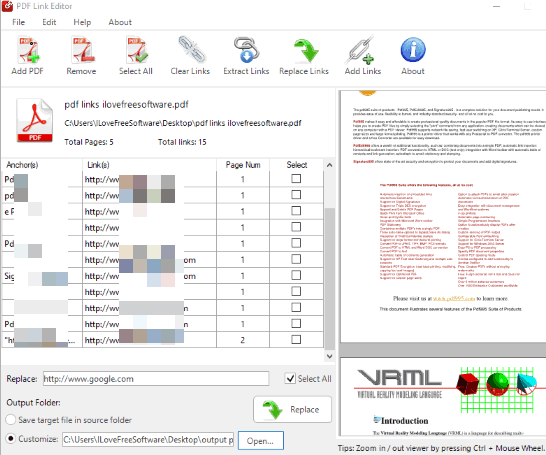


- #Extract links from a web page how to#
- #Extract links from a web page install#
- #Extract links from a web page code#
As you can see there are more than one tag and more than one tag. The price happens to be inside tag, inside a tag. Now, what if we wanted to also get the price of the book? Remember, the highlighted part is how we named our file: php guzzle_requests.php You can execute the file using PHP on the terminal by running the command below. We use the foreach loop to extract the text contents and echo them to the terminal.Īt this step you may choose to do something with your extracted data, maybe assign the data to an array variable, write to file, or store it in a database. We only have one tag containing the, which makes it easier to target it directly.
#Extract links from a web page code#
In the code snippet above, gets the whole list.Įach item in the list has an tag that we are targeting to extract the book’s actual title. $extractedTitles = $title->textContent.PHP_EOL Add the following code to the file: $titles = The next thing you want is to target the text content inside the tag. We then parse the string using XML and assign it to the $xpath variable. The above code snippet will load the web page into a string. $htmlString = (string) $response->getBody() To initialize Guzzle, XML and Xpath, add the following code to the guzzle_requests.php file: get('') It is inside the, which is in turn inside the, which is inside the, which is finally inside the element. You can see that the list is contained inside the element. Here is a screenshot showing a snippet of the page source: In this case, you can view the HTML layout of this page by right-clicking on the page, just above the first product in the list, and selecting Inspect. The first step in scraping a website is understanding its HTML layout. We want to extract the titles of the books and display them on the terminal. The Books to Scrape website looks like this: You should be able to follow the same steps we define here to scrape any website of your choice. We will call it guzzle_requests.php.įor this demonstration, we will be scraping the Books to Scrape website. Once you've installed Guzzle, let’s create a new PHP file to which we will be adding the code. Start by installing Guzzle via composer by executing the following command in your terminal: composer require guzzlehttp/guzzle Let’s see how we can use these three tools together to scrape a website. XML is a markup language that encodes documents so they're human-readable and machine-readable.Īnd XPath is a query language that navigates and selects XML nodes. It has a simple interface for building query strings. Guzzle is a PHP HTTP client that lets you send HTTP requests quickly and easily. Web Scraping with PHP using Guzzle, XML, and XPath Run the following two commands in your terminal to initialize the composer.json file: composer init - require=”php >=7.4" - no-interaction Once you are done with all that, create a project directory and navigate into the directory: mkdir php_scraper
#Extract links from a web page install#
#Extract links from a web page how to#
😉) How to Set Up the Projectīefore we begin, if you would like to follow along and try out the code, here are some prerequisites for your development environment: (Who knows – if you ask politely, they may even give you an API key so you don't have to scrape. Scraping data – even if it's publicly accessible – can potentially overload a website's servers. Note: before you scrape a website, you should carefully read their Terms of Service to make sure they are OK with being scraped. The tools we will discuss are Guzzle, Goutte, Simple HTML DOM, and the headless browser Symfony Panther. In this tutorial, we will be discussing the various tools and services you can use with PHP to scrap a web page. And you can implement a web scraper using plain PHP code.īut since we do not want to reinvent the wheel, we can leverage some readily available open-source PHP web scraping libraries to help us collect our data. PHP is a widely used back-end scripting language for creating dynamic websites and web applications. It's also called web crawling or web data extraction. The code was reasonably simple but there’s now an even easier way to solve the same problem using the new Html.Table () function. The example below prints all links on a webpage:įor link in soup.Web scraping lets you collect data from web pages across the internet. Last year I blogged about how to use the Text.BetweenDelimiters () function to extract all the links from the href attributes in the source of a web page. It provides simple method for searching, navigating and modifying the parse tree. The BeautifulSoup module can handle HTML and XML. The module BeautifulSoup is designed for web scraping. Web scraping is the technique to extract data from a website.


 0 kommentar(er)
0 kommentar(er)
